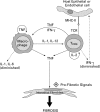Idiopathic pneumonia syndrome after bone marrow transplantation: the role of pre-transplant radiation conditioning and local cytokine dysregulation in promoting lung inflammation and fibrosis
- PMID: 11454101
- PMCID: PMC2517701
- DOI: 10.1111/j.1365-2613.2001.iep0082-0101-x
Idiopathic pneumonia syndrome after bone marrow transplantation: the role of pre-transplant radiation conditioning and local cytokine dysregulation in promoting lung inflammation and fibrosis
Abstract
Pulmonary complications and graft-vs.-host disease (GVHD) remain severe threats to survival after bone marrow transplantation (BMT). Idiopathic pneumonia syndrome (IPS) accounts for nearly 50% of all the cases of interstitial pneumonitis after BMT. IPS is characterized by an early inflammatory phase followed by chronic inflammation and fibrosis of lung tissue; however, the immunopathogenesis of this disease is not yet clearly understood. This biphasic syndrome has been reported to be associated with pre-transplant radiation conditioning in some studies while others have suggested that GVHD or autoimmune phenomena may be responsible for its development. The early post-BMT phase is characterized by the presence of inflammatory cytokines whose net effect is to promote lymphocyte influx into lungs with minimal fibrosis, that leads to an acute form of graft-vs.-host reaction-mediated pulmonary tissue damage. Gradual changes over time in leucocyte influx and activation lead to dysregulated wound repair mechanisms resulting from the shift in the balance of cytokines that promote fibrosis. Using data from new animal models of IPS and information from studies of human IPS, we hypothesize that cytokine-modulated immunological mechanisms which occur during the acute and chronic phases after bone marrow transplantation lead to the development of the progressive, inflammatory, and fibrotic lung disease typical of idiopathic pneumonia syndrome.
Figures



Similar articles
-
Idiopathic pneumonia syndrome after allogeneic bone marrow transplantation in mice. Role of pretransplant radiation conditioning.Am J Respir Cell Mol Biol. 1999 Jun;20(6):1116-24. doi: 10.1165/ajrcmb.20.6.3455. Am J Respir Cell Mol Biol. 1999. PMID: 10340930
-
Idiopathic pneumonia syndrome in mice after allogeneic bone marrow transplantation.Am J Respir Cell Mol Biol. 1998 Feb;18(2):235-42. doi: 10.1165/ajrcmb.18.2.2988. Am J Respir Cell Mol Biol. 1998. PMID: 9476911
-
The critical early proinflammatory events associated with idiopathic pneumonia syndrome in irradiated murine allogeneic recipients are due to donor T cell infusion and potentiated by cyclophosphamide.J Clin Invest. 1997 Sep 1;100(5):1015-27. doi: 10.1172/JCI119612. J Clin Invest. 1997. PMID: 9276718 Free PMC article.
-
Inflammatory reactions induced by pretransplant conditioning--an alternative target for modulation of acute GvHD and complications following allogeneic bone marrow transplantation?Leuk Lymphoma. 1997 Apr;25(3-4):217-24. doi: 10.3109/10428199709114161. Leuk Lymphoma. 1997. PMID: 9168432 Review.
-
[Pulmonary complications after bone marrow transplantation].Minerva Pediatr. 1993 Apr;45(4):141-50. Minerva Pediatr. 1993. PMID: 8355644 Review. Italian.
Cited by
-
Loss of CCR2 signaling alters leukocyte recruitment and exacerbates γ-herpesvirus-induced pneumonitis and fibrosis following bone marrow transplantation.Am J Physiol Lung Cell Mol Physiol. 2016 Sep 1;311(3):L611-27. doi: 10.1152/ajplung.00193.2016. Epub 2016 Jul 22. Am J Physiol Lung Cell Mol Physiol. 2016. PMID: 27448666 Free PMC article.
-
High-resolution computed tomography features of pulmonary chronic graft-versus-host disease following hematopoietic stem cell transplantation: histopathological correlation.Jpn J Radiol. 2011 Feb;29(2):116-28. doi: 10.1007/s11604-010-0526-x. Epub 2011 Feb 27. Jpn J Radiol. 2011. PMID: 21359937
-
Endothelial Dysfunction Syndromes after Allogeneic Stem Cell Transplantation.Cancers (Basel). 2023 Jan 22;15(3):680. doi: 10.3390/cancers15030680. Cancers (Basel). 2023. PMID: 36765638 Free PMC article. Review.
-
Defibrotide modulates pulmonary endothelial cell activation and protects against lung inflammation in pre-clinical models of LPS-induced lung injury and idiopathic pneumonia syndrome.Front Immunol. 2023 Jun 27;14:1186422. doi: 10.3389/fimmu.2023.1186422. eCollection 2023. Front Immunol. 2023. PMID: 37441074 Free PMC article.
-
The impact of soluble tumor necrosis factor receptor etanercept on the treatment of idiopathic pneumonia syndrome after allogeneic hematopoietic stem cell transplantation.Blood. 2008 Oct 15;112(8):3073-81. doi: 10.1182/blood-2008-03-143412. Epub 2008 Jul 29. Blood. 2008. PMID: 18664626 Free PMC article.
References
-
- Agelli M, Wahl SM. Cytokines and fibrosis. Clin. Exp Rheumatol. 1986;4:379–388. - PubMed
-
- Allen RD, Staley TA, Sidman CL. Differential cytokine expression in acute and chronic murine graft-versus-host disease. European J. Immunology. 1993;23:333–337. - PubMed
-
- Anscher MS, Murase T, Prescott DM, et al. Changes in plasma TGFβ levels during pulmonary radiotherapy as a predictor of the risk of developing radiation pneumonitis. Int. J. Radiat. Oncol. Biol. Phys. 1994;30:671–676. - PubMed
-
- Antin JH, Ferrara JLM. Cytokine dysregulation and acute graft-versus-host disease. Blood. 1992;80:2964–2968. - PubMed
-
- Ash RC, Casper JT, Chitambar CR, et al. Successful allogeneic transplantation of T-cell-depleted bone marrow from closely HLA-matched unrelated donors. N. Engl. J. Med. 1990;322:485–494. - PubMed
Publication types
MeSH terms
Substances
Grants and funding
LinkOut - more resources
Full Text Sources
Other Literature Sources
Medical

